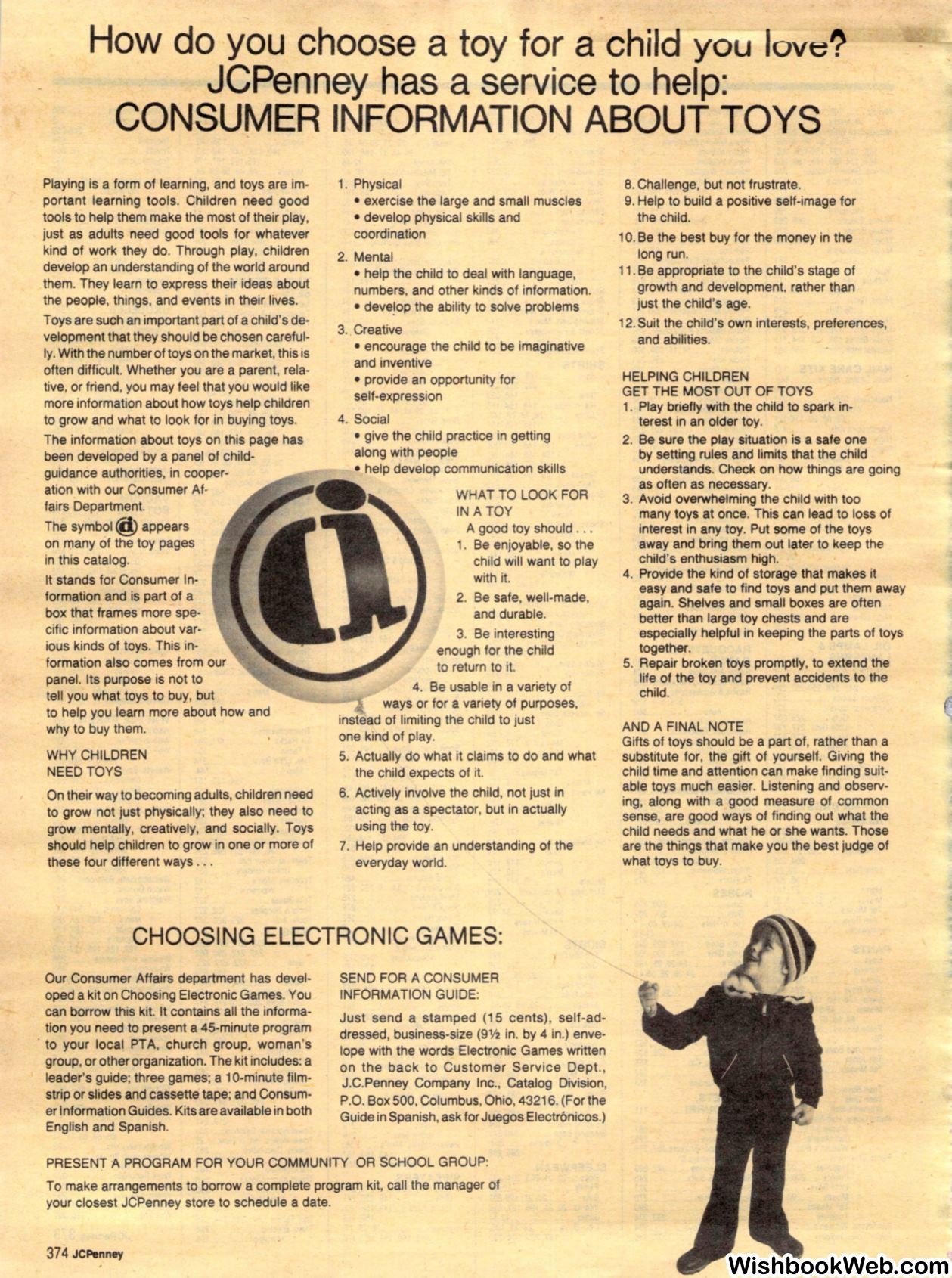

How do you choose a toy for a child
you
love'?
JCPenney has a service to help:
CONSUMER INFORMATION ABOUT TOYS
Playing is a form of learning, and toys are im–
portant learning tools. Children need good
tools to help them make the most of their play,
just as adults need good tools for whatever
kind of work they do. Through play, children
develop an understanding of the world around
them. They learn to express their ideas about
the people, things, and events in their lives.
Toys are such an important part of a child's de–
velopment that they should be chosen careful–
ly. With the number of toys on the market,this is
often difficult. Whether you are a parent, rela–
tive, or friend, you may feel that you would like
more information about how toys help children
to grow and what to look for in buying toys.
The information about toys on this page has
been developed by a panel of child–
guidance authorities, in cooper–
ation with our Consumer Af–
fairs Department.
The symbol@ appears
on n;iany
cit
the toy pages
in this catalog.
It stands for Consumer In–
formation and is part of a
box that frames more spe–
cific information about var–
ious kinds of toys. This in–
formation also comes from our
panel. Its purpose is not to
tell you what toys to buy, but
to help you learn more about how and
why to buy them.
WHY CHILDREN
NEED TOYS
On their way to becoming adults, children need
to grow not just physically; they also need to
grow mentally, creatively, and socially. Toys
should help children to grow in one or more of
these four different ways ...
1. Physical
• exercise the large and small muscles
• develop physical skills and
coordination
2. Mental
• help the child to deal with language,
numbers, and other kinds of information.
• develop the ability to solve problems
3..Creative
• encourage the child to be imaginative
and inventive
• provide an opportunity for
self-expression
4. Social
WHAT TO LOOK FOR
IN A TOY
A good toy should ...
1. Be enjoyable, so the
child will want to play
with it.
2. Be safe, well-made,
and durable.
3. Be interesting
enough for the child
to return to it.
4. Be usable in a variety of
ways or for a variety of purposes,
instead of limiting the child to just
one kind of play.
5. Actually do what it claims to do and what
the child expects of it.
6. Actively involve the child, not just in
acting as a spectator, but in actually
using the toy.
7. Help provide an understanding of the
everyday world.
CHOOSING ELECTRONIC GAMES:
Our Consumer Affairs department has devel–
oped a kit on Choosing Electronic Games. You
can borrow this kit. It contains all the informa–
tion you need to present a 45-minute program
· to your local PTA, church group, woman's
group, or other organization. The kit includes: a
leader's guide; three games; a 10-minute film–
strip or slides and cassette tape; and Consum–
er Information Guides. Kits are available in both
English and Spanish.
SEND FOR A CONSUMER
INFORMATION GUIDE:
Just send a stamped (15 cents), self-ad–
dressed, business-size
(9Y2
in. by 4 in.) enve–
lope with the words Electronic Games written
on the back to Customer Service Dept.,
J.C.Penney Company Inc., Catalog Division,
P.O. Box 500, Columbus, Ohio, 43216. (For the
Guide in Spanish,ask for Juegos Electr6nicos.)
PRESENT A PROGRAM FOR YOUR COMMUNITY OR SCHOOL GROUP:
To make arrangements to borrow a complete program kit, call the manager of
your closest JCPenney store to schedule a date.
374
JCPenney
8. Challenge, but not frustrate.
9.
Help to build a positive self-image for
the child.
10. Be the best buy for the money in the
long run.
11. Be appropriate to the child's stage of
growth and development. rather than
just the child's age.
12.Suit the child's own interests, preferences,
and abilities.
HELPING CHILDREN
GET THE MOST OUT OF TOYS
1. Play briefly with the child to spark in–
terest in an older toy.
2. Be sure the play situation is a safe one
by setting rules and limits that the child
understands. Check on how things are going
as often as necessary.
3. Avoid overwhelming the child with too
many toys at once. This can lead to loss of
interest in any toy. Put some of the toys
away and bring them out later to keep the
child's enthusiasm high.
4. Provide the kind of storage that makes it
easy and safe to find toys and put them away
again. Shelves and small boxes are often
better than large toy chests and are
especially helpful in keeping the parts of toys
together.
5. Repair broken toys promptly, to extend the
life of the toy and prevent accidents to the
child.
AND A FINAL NOTE
Gifts of toys should be a part of, rather than a
substitute for, the gift of yourself. Giving the
child time and attention can make finding suit–
able toys much easier. Listening and observ–
ing, along with a good measure of common
sense, are good ways of finding out what the
child needs and what he or she wants. Those
are the things that make you the best judge of
what toys to buy.
















